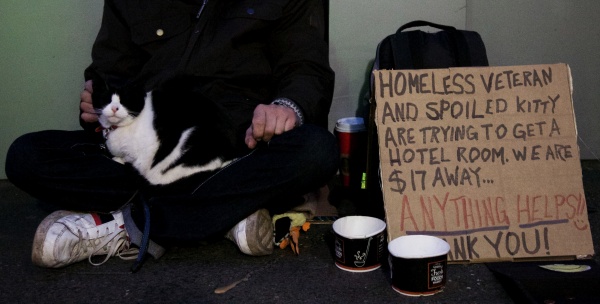Our City’s Homeless are in Trouble
January 29, 2016
Here we are. Another December has passed, another season of giving gone until next year. With this time came joyous Christmas parties, myriad retail outlets filled with discount-crazed shoppers, and for some, generosity toward the less fortunate.
Last December, however, New York Governor Andrew Cuomo signed an executive order for the municipal governments of the state to round up their homeless and bring them to shelters, using force if necessary.
Although Governor Cuomo told NY1 that “it’s about love. It’s about compassion. It’s about helping one another and basic human decency,” I beg to differ.
As Associate Professor of Public Affairs at Baruch College, Thomas J. Main, who studies homelessness, said to the New York Times, “We’re talking about scooping people up who might be resistant. And then what are you going to do? Restrain them at the shelter?”
While the prec10eding policy for New York City, called Code Blue, allowed the homeless to be brought to shelters if they voluntarily came or if they were deemed a danger to themselves or to those around them under the New York Mental Hygiene Law, Cuomo’s executive order makes this policy much more aggressive by permitting force.
Just as the Mental Hygiene Law was already used under this preceding law, the police officers that will be collecting the homeless in freezing temperatures under the new policy are required to interview and determine the mental stability of individuals they believe to be in need of psychiatric care before bringing them to a shelter. Under this law, the homeless cannot simply be rounded up and brought to shelters against their will.
By permitting force in bringing the homeless to shelters, Cuomo is removing their right to deny shelter, criminalizing not going to a shelter and threatening to use the Mental Hygiene Law to determine that the homeless are mentally ill and a danger to themselves for not going to a shelter in freezing temperatures.
Despite the noble goal of trying to shelter all of the homeless across the state, Cuomo’s philosophy that the homeless should be required to go to shelters in freezing weather and that the state’s shelters can currently accommodate every homeless person ignores the reality of the state’s shelter system.
While Mayor Bill de Blasio did recently unveil a program to improve the conditions of New York City’s shelters, they are currently far from ideal.
As Observer.com reported in March 2015, the City Department of Investigation “surveyed 25 shelter facilities operating under the umbrella of the Department of Homeless Services and uncovered 621 violations of sanitation, fire and building codes, and a population of residents complaining of discomfort, fear and unresponsive landlords and management companies.”
This report was “replete with photos of mold, rodents—living and dead—overcrowded rooms, smashed windows, ruined walls and rusted-out elevators and stairs, but also contains a plan to clean up the entire citywide network of 161 buildings housing 11,900 families.”
The report also stated that “at its worst, DHS is turning a blind eye to violations that threaten the lives of shelter residents.” Additionally, the report claimed that “many shelters operate with existing violations that make life unsafe for its children and family residents.”
Given these deplorable conditions, reminiscent of the workhouses and prisons in industrial England recorded by the likes of Charles Dickens, it becomes absurd to consider a homeless person mentally unstable or making the wrong choice for not wanting to go to a shelter.
To provide some statistics, the Coalition for the Homeless reported in the year of 2009–2010, six homeless people, all non-sheltered, died from “excessive or natural cold.” Eight people, however, were killed in homicides in shelters in the same year. Based on these numbers, it would appear to be in the city’s best interest to improve the shelter system first before trying to take on even more individuals.
Essentially, Cuomo’s executive order will not do any good if the shelters do not have the capacity to accommodate and serve all of the homeless, and if, as statistics show, shelters actually present a more dangerous environment than a freezing city street.
The most puzzling part about the policy, however, is that less than a month after Cuomo signed the executive order, he stated on Jan. 13 that “people have been attacked and victimized in some shelters, and some would rather stay outside in the frigid cold than risk entering—and they are right to do it,” in his State of the State address. This statement was accompanied by the announcement of a plan to review and improve New York City’s homeless shelters.
At the same time, the executive order will continue to be implemented. Rather than improve the shelter system first, and then mandate that all the homeless be taken into the improved shelters, the homeless will, for the time being, continue to be brought to shelters with unacceptable conditions. The worst part is that even Cuomo himself seems to disagree with his own policy of demanding that all of the homeless be sheltered in the state’s current system.
The main thing that needs to be kept in mind is that the homeless deserve nothing less than to be treated as fellow human beings. To say the homeless do not have the right to refuse shelter out of alleged concern for their safety while dozens are allowed to remain and drown in their homes in evacuation zones during natural disasters such as Superstorm Sandy is an unacceptable double standard.
The homeless deserve to be given safe, humane living conditions—something that is not being provided to them nearly enough—and should have the right to reject being subjected to altogether deplorable living conditions.












